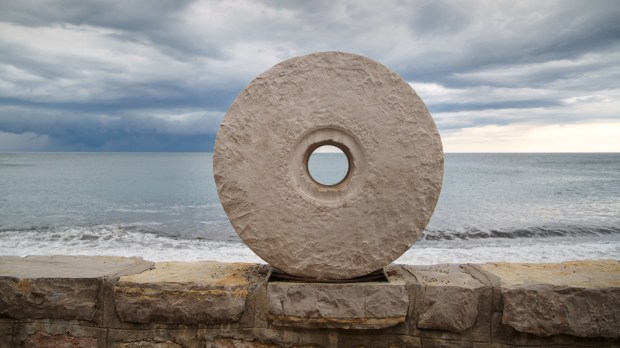What is the literal meaning of the Gospel about the millstone around the neck?
This Sunday’s Gospel is Mk 9:38-43, 45, 47-48
1. Understanding Jesus’ powerful words
It is clear that Jesus did not mean murdering a man. So, what does the statement mean: “Whoever causes one of these little ones who believe in me to sin, it would be better for him if a great millstone were put around his neck and he were thrown into the sea.”
Millstones are two huge circular stones with holes in the middle, placed one atop the other in order to grind grain.
2. Keywords
Whoever causes one of these little ones who believe in me to sin.
First, the word “scandal” (scandalon) is used in this context in the original. It originally meant to trigger a trap or snare. In the Bible, it literally means to cause someone to “stumble” and fall. It is also synonymous with temptation, which is like setting a trap for a person.
Second, Jesus warns against making people worse, being the cause of sin, or making “one of the little ones” fall. We need to note that Jesus is not talking about children (paidia) but “the little ones (microi) who believe.” So, here, Jesus is not just concerned about scandalizing children; his words have a much broader sense. He is concerned with scandalizing the “little ones who believe,” including adults who are growing in faith.
This passage has been often interpreted in the sense of scandal and crime against children and young people who have been sexually abused, including by clergy.
It would be better for him if a great millstone were put around his neck and he were thrown into the sea.
The Romans in Jesus’ time gruesomely executed people by drowning them with a millstone around the neck (katapontismos), as Josephus Flavius attests in his writings.
This punishment also included the fact that such a victim would have no grave and burial; and, in the culture of the Middle East, this was considered the greatest punishment.
In this context, it must be emphasized that Christ, who preached the Gospel of love, life, and forgiveness, certainly did not advocate such a tragic punishment. The Gospel passage is purely hypothetical, using the expression “it would be better” for such a man to have a millstone put around his neck and to be thrown into the sea, rather than have him become a cause of sin/stumbling for one of these little ones in the faith.
3. Today
We are helped in our understanding of this Gospel passage by Simon Légasse, who wrote “the terrible fate of the drowning man with a stone around his neck is nothing compared to what awaits at God’s judgment the one who caused someone to stumble.”


